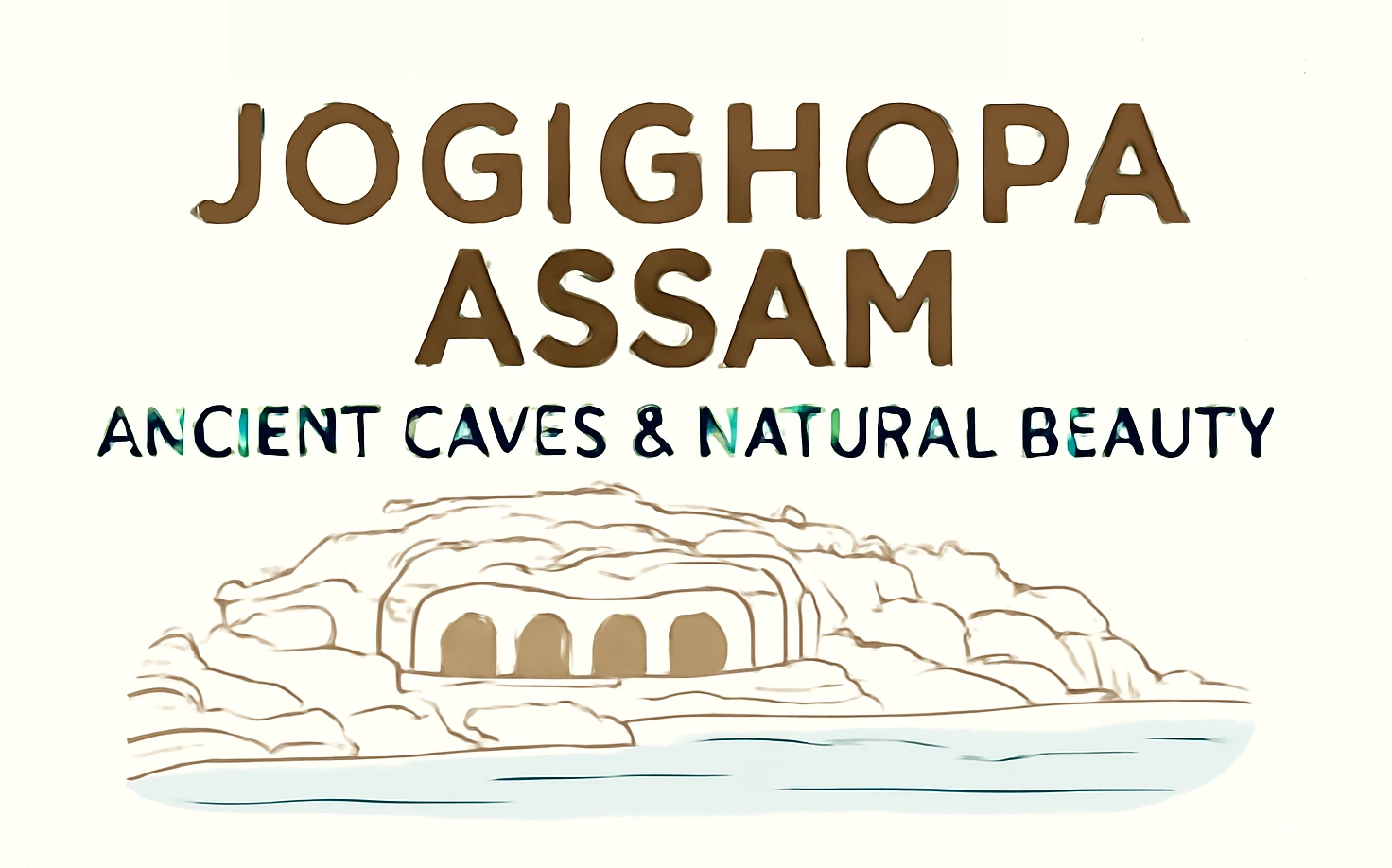Jogighopa is a small town located on the northern bank of the Brahmaputra River in the Bongaigaon district of Assam, India. It is known for the remains of five rock-cut caves from the Mlechchha dynasty period, preserved by the Archaeological Survey of India. The area also includes other localities such as Kabaitary, Chalantapara, Papermil, and Balapara, which together form the greater Jogighopa area. Jogighopa has a combined road-rail bridge called the Naranarayan Setu over the Brahmaputra River, which is an important transport link. The population of Greater Jogighopa was about 65,845 according to the 2011 census and is expected to grow further.
These rock-cut caves are significant examples of Assam’s ancient architecture and are notable for their historical and archaeological value. The town also serves as a transport hub with its railway station code JPZ, connecting various long-distance trains and falling under the North Frontier Railway zone.
Historical Significance of Jogighopa
Jogighopa is renowned for the remains of five unique rock-cut caves dating back to the Salasthambha dynasty period. These caves, carved directly into the rockbanks of the Brahmaputra, are among the rare examples of rock-cut architecture in Assam. Though more modest than the famous rock caves in western India, Jogighopa’s caves bear testimony to the region’s involvement in early Indian art and architecture movements. One of the best-preserved caves measures approximately 2.6 meters in breadth and 1.9 meters in height, featuring a simple yet captivating design with a small verandah and rainwater drainage system carved into the rock.
Jogighopa’s strategic location also made it a historical trade route during the British era, further adding to its cultural significance.
Tourist Attractions in and Around Jogighopa
Visitors to Jogighopa can enjoy a variety of sites that highlight both its cultural heritage and natural beauty:
- Rock Cut Caves of Jogighopa: These ancient caves are a must-visit for history enthusiasts interested in Assam’s medieval past.
- Naranarayan Setu: A double-deck road-rail bridge over the Brahmaputra connecting Jogighopa to Pancharatna on the southern bank. This engineering marvel enhances accessibility and provides scenic river views.
- Pancharatna: Situated opposite Jogighopa, Pancharatna boasts lush green landscapes, ancient monuments, and temples, including a Gupta period temple and a monolithic Buddhist stupa.
- Koyakujia Beel: A beautiful natural lake famous for birdwatching, especially migratory birds during winter.
- Nearby Wildlife Sanctuaries: Including Kakoijana Wildlife Sanctuary and Chakrasila Wildlife Sanctuary, rich in biodiversity and home to rare species like the golden langur.
- Nature Spots: Nakkati Hills offers panoramic views and hiking trails, while the lush forests around Jogighopa provide perfect spots for nature lovers and picnic enthusiasts.
Best Time to Visit
The ideal time to explore Jogighopa is between October and December, when the weather is pleasant and ideal for sightseeing and outdoor activities. Avoid the monsoon season (June to September) due to heavy rainfall, which can disrupt travel plans.
Also read: Kareng Ghar: The Majestic Palace of Assam’s Ahom Dynasty
How to Reach Jogighopa
Jogighopa is well-connected by rail and road. The Jogighopa railway station (station code JPZ) connects it to major Indian cities and towns via the North Frontier Railway zone. The nearest major airport is in Guwahati, about 210 km away, with regular luxury bus and taxi services available from there to Jogighopa. The Naranarayan Setu bridge facilitates easy road travel between Jogighopa and the southern banks of the Brahmaputra.
Practical Tips for Tourists
- Plan your visit during the winter months for comfortable weather.
- Respect local customs and traditions to enhance your cultural experience.
- Explore the local markets and try Assamese cuisine to truly savor the region’s culture.
- Carry appropriate hiking shoes if visiting the Nakkati Hills or wildlife sanctuaries.
- Utilize local transportation like rental cars or tourist buses from Bongaigaon for easy commuting to nearby attractions.
Jogighopa offers a rare combination of ancient historical sites and serene natural beauty, making it an unforgettable destination for travelers seeking to explore Assam beyond the usual tourist circuits. Whether fascinated by architecture, wildlife, or picturesque landscapes, Jogighopa promises a diverse and enriching experience.
FAQs on Jogighopa
Q1: Where is Jogighopa located?
A: Jogighopa is a town located on the northern bank of the Brahmaputra River in the Bongaigaon district of Assam, India.
Q2: What is Jogighopa famous for?
A: Jogighopa is famous for its ancient rock-cut caves from the Salasthambha dynasty era and the Naranarayan Setu, a road-rail bridge over the Brahmaputra.
Q3: How can one reach Jogighopa?
A: Jogighopa is accessible by rail via Jogighopa railway station (JPZ) and by road through the Naranarayan Setu bridge. The nearest airport is Guwahati Airport.
Q4: What is the best time to visit Jogighopa?
A: The best time to visit Jogighopa is between October and December when the weather is pleasant and suitable for sightseeing.
Q5: Are there any wildlife sanctuaries near Jogighopa?
A: Yes, there are several wildlife sanctuaries near Jogighopa, including Kakoijana Wildlife Sanctuary and Chakrasila Wildlife Sanctuary, known for their rich biodiversity.
MCQs on Jogighopa
Q1. What ancient structures is Jogighopa known for?
a) Temples built in the 20th century
b) Rock-cut caves from the Salasthambha dynasty
c) Modern museums
d) British colonial buildings
Answer: b) Rock-cut caves from the Salasthambha dynasty
Q2. The Naranarayan Setu connects Jogighopa to which nearby area?
a) Guwahati
b) Pancharatna
c) Diphu
d) Tezpur
Answer: b) Pancharatna
Q3. Which river flows by Jogighopa?
a) Ganges
b) Brahmaputra
c) Yamuna
d) Mahanadi
Answer: b) Brahmaputra

